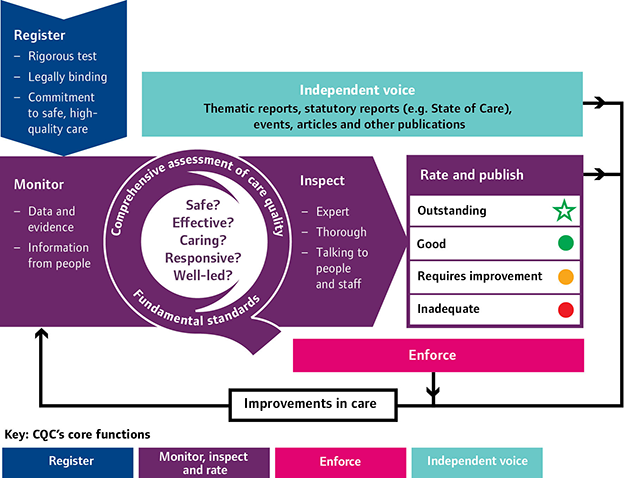@2021 invictIQ is a venture by Sprint Consultancy. All rights reserved. Privacy Policy.


Mastering the CQC Connection!
by Mark Topps
Before the days of the Single Assessment Framework it was easier to have a relationship with the regulator. The new framework saw a change in the CQC’s staffing structure and the removal of named inspectors. Whilst the removal of these named inspectors will provide equality to all services as some had this and some didn’t, I think it is a great loss. I remember fondly the relationships I have had over the year with inspectors, the ability to be able to phone for advice, and as opposed to removing this function, I would have preferred the CQC to have gone the other way and given all services one. In this blog, I look at how to manage your relationship with the inspectorate.
Build the foundations
The first thing in any new relationship is getting to know the other person, and your relationship with the CQC is no different. You need to familiarise yourself with what they do, their new Single Assessment Framework, the Fundamental Standards, Quality Statements and their website.
Once you have done your research you will need to introduce your findings to your staff team so that you can upskill them and ensure they know the regulators expectations. Regular bite sized training sessions will help in keeping everyone informed and compliant with regulations as opposed to one big one off session.
By building the foundations, you will have a better understanding of why they ask the questions they ask/do what they do and be on the same page.
Communicate
One of the key factors in building a relationship is effective communication. Whilst you will not have the named inspector, this should not stop you communicating. You should communicate clearly and respectfully with the inspector before, during and after the inspection. This means providing accurate and timely information, answering any questions and addressing any issues or concerns.
The new framework is built on risk, and whilst the proposal is for services to have more regular inspections, this doesn’t mean that they will cross the threshold and come into your service and nor do we know this will actually be the case, so be sure to communicate, even if it is one sided. Here are some things you can do:
- Ask Questions – The regulator acknowledges that they need to communicate better and engage with providers, so utilise this.
- Seek Guidance – If you are unsure about any aspect of CQC compliance, don’t hesitate to seek guidance. Whilst I have found the CQC won’t provide additional resources and often the expected support you want from them falls short, they will be able to sign post you and give you a different perspective of looking at the situation.
- Ask for an inspection – if you are new to the service or you haven’t been inspected recently, request an exploratory inspection. It may be that they refuse but at least the regulator can see you are trying and willing.
- Send weekly updates – whilst you may not have a named inspector, all emails are linked on the CQC system to your service, so be sure to send in weekly updates. We know inspections will be targeted and focused but also utilise data, so your weekly emails could contain some of this data to help the rating outcome. In your weekly email you should include:
- Highlights – what has gone well. Remember to include positive impact to people you care for.
- Lowlights – what didn’t quite go to plan, but lessons learnt and action taken.
- Any key developments
- Audit outcomes and actions taken.
- Any issues that invoked your contingency plan such as staffing levels.
- Incidents/accidents that have happened and what you have done about it.
- Feedback from relatives, those using your service, stakeholders, staff etc and actions taken as a result of these.
- Any upcoming events or changes – these will evidence community involvement, provider development etc.
Implement feedback
Take any feedback seriously. Address any concerns or recommendations promptly and thoroughly and make sure you communicate progress. Use other reports on providers by the CQC as a tool for improvement. Don’t focus on the outstanding elements, but on the areas that were a risk to the regulator.
Utilise engagement opportunities
Join care sector forums and events where you can engage with the CQC and other stakeholders. These forums provide a platform for sharing industry best practices and discussing common challenges. Some of the trade shows have slots you can book for 1:1 sessions with the regulator, which is a perfect chance to ask questions and be informed.
Other ways to utilise engagement is:
- If you have notice of an inspection, request a pre-inspection meeting and use these to discuss your organisation’s approach to quality and safety and to ask any questions.
- During inspections engage with inspectors by answering questions and providing necessary documentation.
- Actively participate in CQC consultations.
- Become a member of the CQC Citizen Lab which is a platform where the regulator seeks to engage through discussions, reviewing documents, polls, surveys and idea boards. You can join for free here.
Stay informed
Keep abreast of any changes in CQC regulations and guidelines. Regularly check for updates on their website and attend any training sessions or workshops they offer. You can find their events here.
Final thoughts
Managing the relationship with the CQC is in your hands. I hope this blog gives you some ideas of things you can implement The main takeaway should be that communication is key… do all you can to involve and update the regulator about your service.
MORE ARTICLES


Mark Topps is a social care leader who has worked in the care industry since 2004 and is currently working as a regional support manager. He regularly advocates, appearing on television, radio and podcasts and has started many campaigns for change in legislation and culture within the industry. Mark is the co-founder of The Caring View which is a social care podcast, YouTube show and free resource initiative for the sector. He also co-founded The Health and Social Care Club, which is an audio event hosted on LinkedIn. Mark is also the social media and marketing director at the National Association of Care and Support Workers.
Share
Sign up for our newsletter

